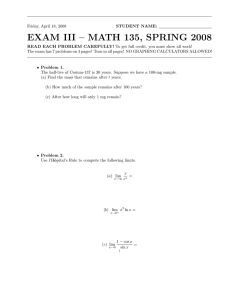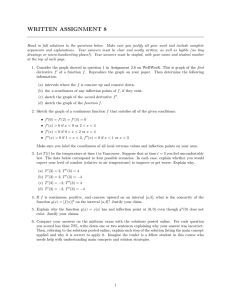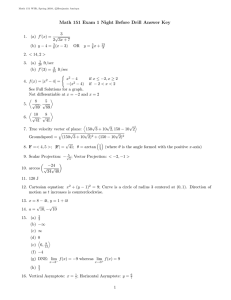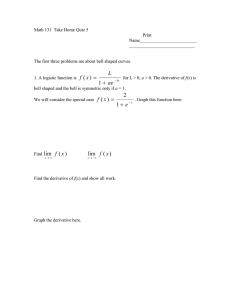·9 WORKSHOP 2
advertisement
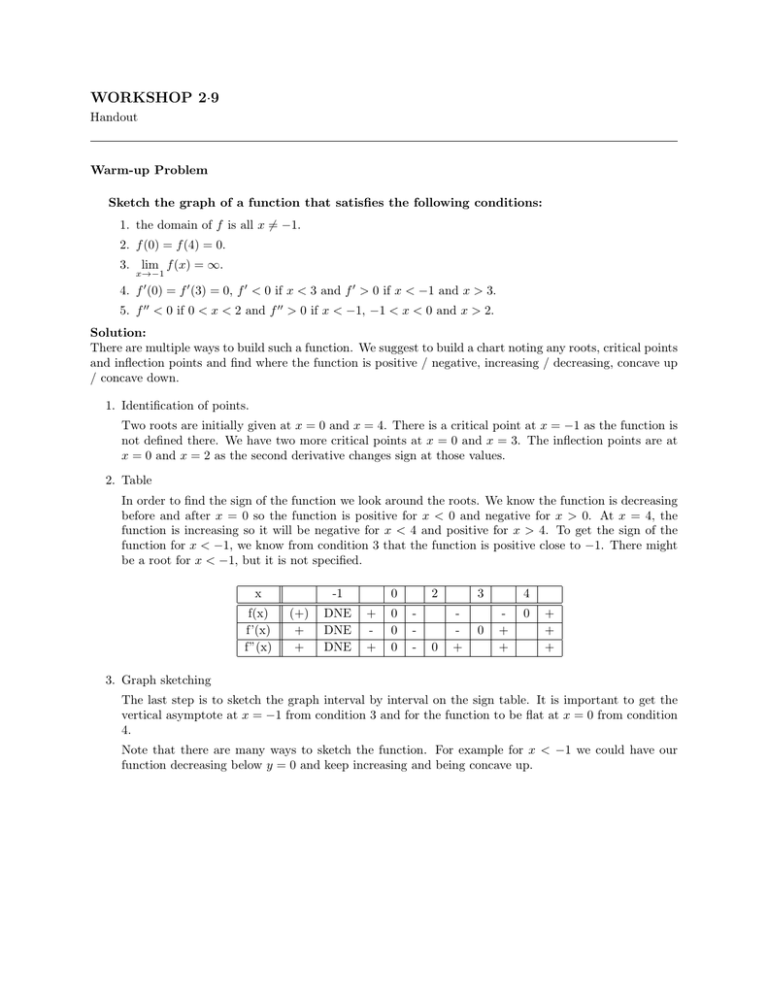
WORKSHOP 2·9 Handout Warm-up Problem Sketch the graph of a function that satisfies the following conditions: 1. the domain of f is all x 6= −1. 2. f (0) = f (4) = 0. 3. lim f (x) = ∞. x→−1 4. f 0 (0) = f 0 (3) = 0, f 0 < 0 if x < 3 and f 0 > 0 if x < −1 and x > 3. 5. f 00 < 0 if 0 < x < 2 and f 00 > 0 if x < −1, −1 < x < 0 and x > 2. Solution: There are multiple ways to build such a function. We suggest to build a chart noting any roots, critical points and inflection points and find where the function is positive / negative, increasing / decreasing, concave up / concave down. 1. Identification of points. Two roots are initially given at x = 0 and x = 4. There is a critical point at x = −1 as the function is not defined there. We have two more critical points at x = 0 and x = 3. The inflection points are at x = 0 and x = 2 as the second derivative changes sign at those values. 2. Table In order to find the sign of the function we look around the roots. We know the function is decreasing before and after x = 0 so the function is positive for x < 0 and negative for x > 0. At x = 4, the function is increasing so it will be negative for x < 4 and positive for x > 4. To get the sign of the function for x < −1, we know from condition 3 that the function is positive close to −1. There might be a root for x < −1, but it is not specified. x f(x) f’(x) f”(x) -1 (+) + + DNE DNE DNE 0 + + 0 0 0 2 - 0 3 + 0 4 + + 0 + + + 3. Graph sketching The last step is to sketch the graph interval by interval on the sign table. It is important to get the vertical asymptote at x = −1 from condition 3 and for the function to be flat at x = 0 from condition 4. Note that there are many ways to sketch the function. For example for x < −1 we could have our function decreasing below y = 0 and keep increasing and being concave up. y −1 1 x Figure 1: Sketch of the described function. Main Problem Let E denote the energy expenditure per metre of a fish swimming at a speed x against a current of speed u. For a fish swimming again a current u, so for x > u, E(x) is modelled by the equation aebx E(x) = , x−u where a and b are positive constants depending on the species and size of the fish. Predict the shape of the graph of the function E(x), and draw your prediction on the board. Then, set a = 1 and u = 1. Use calculus to sketch the actual graph of the function E(x), indicating where it is increasing and decreasing, and where it has asymptotes. At what swimming speed does the fish travel most efficiently? Solution: First of all if the fish moves at speed x = u it does not move, so the energy expenditure will be infinite as it is spending all that energy to not move. We should then get a vertical asymptote at x = u. Then as the speed picks up the energy expenditure gets gradually smaller. If x is too big the resistance of water gets too strong and it takes too much energy to move, so the energy expenditure per meter increases again, so there should be a local minimum at x = c for c > u. Finally the function needs to be positive, so there can be no roots. We can expect it to look like Figure 2. We will check this prediction by following the five steps outlined in the mini-lecture. 1. Domain This was stated to be any x value greater than u. 2. Intercepts Since x = 0 is not in the domain, we don’t have any y-intercept. We don’t have x-intercepts either as the numerator of E(x) is an exponential function, which is never equal to zero. 3. Asymptotes There is potentially an asymptote at x = u if we compute the limit, we see that the numerator goes to bebu , a finite positive number as the denominator goes to zero, but stays positive as x > v. The result y v c x Figure 2: Prediction of E(x). bu is that the limit is of be0+ form and is equal to positive infinity and we have a vertical asymptote at x = u that goes to positive infinity. lim+ E(x) = +∞. x→u Moreover, we won’t have a horizontal asymptote as x → ∞ as the limit will also go to infinity. aebx x→∞ x − u (aebx )0 = lim x→∞ (x − u)0 lim E(x) = lim x→∞ (L’Hôpital’s Rule) = lim abebx = ∞. x→∞ 4. Critical Points and intervals of increase/decrease We will first find the first derivative for a = u = 1: bebx (x − 1) − ebx (x − 1)2 bx e (bx − b − 1) = (x − 1)2 E 0 (x) = First of all let’s find the critical points. There cannot be any roots as the numerator of E(x) is always positive (positive constant times an exponential, which is always positive). To find the critical points, the numerator of E 0 (x) needs to be zero, so we need to solve bx − b − 1 = 0 b+1 1 x= =1+ b b This is strictly greater than u so we expect this to be our minimum. There is another critical point at x = u but we already determined this to be a vertical asymptote. To verify we have a minimum, we check the first derivative on either side of x = 1 + 1/b. Let x = 1 + 1/2b, then v < x < c. In that case we have bx − b − 1 = b + 0.5 − b − 1 = −0.5 < 0 so the derivative is negative (all other factors are positive) and the function is decreasing. Let x = 1 + 2/b, then we have bx − b − 1 = b + 2 − b − 1 =1>0 so the derivative is positive and the function is increasing. The function goes from decreasing to increasing as we go across our critical point, so it is a local minimum. 5. Inflection points and concavity (optional in the workshop) Let’s first find the second derivative (bebx (bx − b − 1) + bebx )(x − 1)2 − ebx (bx − b − 1)2(x − 1) (x − 1)4 bx (be (bx − b))(x − 1) − 2ebx (bx − b − 1) = (x − 1)3 bx 2 2 2 be (b x − 2b x + b2 − 2bx + 2b + 2) = . (x − 1)3 E 00 (x) = To find Inflection points we need to solve the following b2 x2 − (2b2 + 2b)x + (b2 + 2b + 2) = 0. This is a quadratic function for x. We can compute the discriminant (b2 − 4ac) ∆ = (2b2 + 2b)2 − 4b2 (b2 + 2b + 2) = (4b4 + 8b3 + 4b2 ) − (4b4 + 8b3 + 8b2 ) = −4b2 < 0. Because the discriminant is negative there can be no root and thus no inflection point. Finally to find concavity, we only need to check the second derivative at any point x > v and the concavity should remain the same because there are no inflection point in the interval. Let’s take x = 2. b2 x2 − (2b2 + 2b)x + (b2 + 2b + 2) = b2 · 22 − (2b2 + 2b)2 + (b2 + 2b + 2) = 4b2 − 4b2 − 4b + b2 + 2b + 2 = b2 − 2b + 1 + 1 = (b − 1)2 + 1 > 0 so the function is concave up. Recapitulating, we have a vertical asymptote at x = 1 at positive infinity, then the function decreases until it reaches the minimum at c = 1 + 1/b and then increases for x > c all the while it retains a concave up shape. This is very similar to our predictions. By comparison below is a numerically computed graph for b = 1. It has the same general shape, but the first corner is in fact sharper than the second one. This cannot be found using the tools we have.

